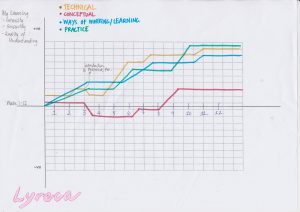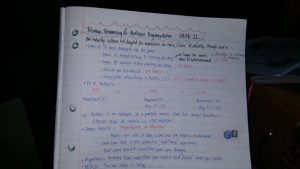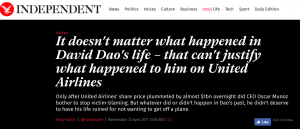I) what you consider to be the most successful and problematic aspects of the submitted work
Each group member had their own individual sections to edit based on what we researched, therefore, I will be mainly talking about my part – it begins with “Despite hip hop’s positive and colourful foundations…” and ends with the chorus of Superbass – Nicki Minaj. For the successful bits of my audio, I’d say that it was incorporating the music + songs/interviews/sound effects with the me speaking throughout the piece. It was well-timed and matched perfectly with what I was saying, of course. For example, within the first section, I immediately mention the apparent sexism within the music industry and with the examples I have provided, the lyrics of the chosen songs go well with each other. I believe it is because these chosen songs were all within the same genre (obviously hip hop/rap) and were not too musically different.
On the other hand, there were definitely mistakes involved within this piece. Don’t get me wrong – I am very proud of my work but of course, there was a bit of error within certain parts of the piece that kind of irritated because it was extremely hard to fix – this is something that is irreplaceable in the realm of editing, and should have been corrected during the production of this piece. It was my shaky voice, occasional stutters and my muttering. For some parts of this audio, it was difficult to make out what I was saying half the time and I had to cut out sections where I often stuttered because it did not sound great in any way! So yes, unfortunately, this is something that could have been resolved during production but certain factors hindered the solution; my laziness and the time limit (as we have booked the room for only 2 hours). Otherwise, I believe my work/section is on topic with the whole theme of our piece – Where did Women in Hip Hop go?
II) how your audio work ‘plugs in’ to concepts and theories as raised in lectures, class discussion, and reading
As this project is essentially the concept of “our attention”, our group has decided to work on a topic that has been a big thing for past generations and is still highly relevant in today’s music scene. In terms of the concept/theories that we have reflected on this piece, we have based it off the audio activities we partook in during the workshop. The audio that we heard during the workshop (My Lobotomy) had a variety of texture within the audio – from archival sound, to the atmospheric sound, everything was there to set the mood. This is what we intended to do in our piece, however, our topic dealt with music and the only type of audio we could play around with were songs, instrumentals people talking and less about the atmos, archival sound, etc. We did not have to limit ourselves in that sense but it only made sense to stick to certain types of sounds.
III) what you learnt about the different affordances of audio-based media
This was a new platform for me to work on in comparison to Premiere Pro because I have already been previously exposed to video editing softwares such as iMovie, MovieMaker, etc. I did have little experience with GarageBand, but it was mostly for using the beats as instrumentals for my videos. Audition was a completely brand new experience for me but I have to say – it was so much more easier to use than Premiere! I was honestly worried when we were introduced to a new software very late within the semester but after having a feel of Audition, it was so much easier to use. Thus, I had more access and ability to a more creative piece, without the stress of having to figure a whole new language, pretty much. I was also expecting recording the audio to be a breeze, but it was so much more harder than expected – like I previously said, I muttered, stuttered and was nervous! Getting to know the process and the “different affordances of audio-based media” was a challenging yet fun process to be a part of.
IV) and what you learnt in the making process about collaboration that might be relevant to your broader development as a media practitioner.
As my first ever collaboration in Media, I was privileged to be grouped with like-minded individuals so there wasn’t much conflict when it came to the brainstorming of ideas and the creation of the work. We all agreed when it came to editing the work and also tried to work around the constraints of the word. I have to say, a 7-8 minute piece is definitely not enough – this is the only thing that challenged us together as group members but otherwise, I have learnt a lot being in a group, which is helpful to my development as a media practitioner.
lik







